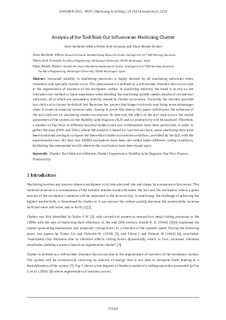Title
Analysis of the Tool Stick-Out Influence on Machining ChatterAuthor
Publication Date
2021Other institutions
Danish Advanced Manufacturing Research CenterVersion
Published versionDocument type
Conference ObjectConference ObjectLanguage
EnglishRights
© 2021 The authorsAccess
Open accessPublisher’s version
https://doi.org/10.25518/esaform21.2224Published at
ESAFORM Proceedings N. artículo, 2224, 2021Keywords
Chatter
Tool Stick-out Influence
Chatter Suppression
Stability Lobe Diagram ... [+]
Tool Stick-out Influence
Chatter Suppression
Stability Lobe Diagram ... [+]
Chatter
Tool Stick-out Influence
Chatter Suppression
Stability Lobe Diagram
Tap-Test
Process Productivity [-]
Tool Stick-out Influence
Chatter Suppression
Stability Lobe Diagram
Tap-Test
Process Productivity [-]
Abstract
Increased stability in machining processes is highly desired by all machining industries when vibrations and specially chatter occur. This phenomenon is defined as a self-excited vibration that occurs ... [+]
Increased stability in machining processes is highly desired by all machining industries when vibrations and specially chatter occur. This phenomenon is defined as a self-excited vibration that occurs due to the regeneration of waviness of the workpiece surface. In machining industry, the trend is to rely on the trial and error method or mere experience when deciding the machining spindle speeds, depths of cut and tool stick-outs, all of which are parameters directly related to chatter occurrence. Currently, the shortest possible tool stick-out is chosen by default, but literature has proven that longer stick-outs may bring some advantages when it comes to material removal rates. Aiming to prove this theory, this paper will discuss the influence of the tool stick-out on machining chatter occurrence. To that end, the effect of the tool stick-out on the modal parameters of the system, on the Stability Lobe Diagram (SLD) and on productivity will be analysed. Therefore, a number of Tap-Tests to different tool/tool-holder/stick-out combinations have been performed, in order to gather the data (FRFs and SLDs) where the analysis is based on. Last but not least, some machining tests have been conducted aiming to compare the theoretical chatter occurrence conditions, provided by the SLD, with the experimental ones. For that, two Al5083 workpieces have been slot milled under different cutting conditions, facilitating the unexpected results wherein the conclusions have been based upon. [-]
Collections
The following license files are associated with this item:






















